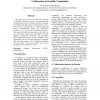Free Online Productivity Tools
i2Speak
i2Symbol
i2OCR
iTex2Img
iWeb2Print
iWeb2Shot
i2Type
iPdf2Split
iPdf2Merge
i2Bopomofo
i2Arabic
i2Style
i2Image
i2PDF
iLatex2Rtf
Sci2ools
CSCWD
2008
Springer
2008
Springer
Collaboration in scientific visualization
This paper discusses the key collaborative features of scientific visualization systems. An experiment with several groups of users has been conducted to evaluate the usability and effectiveness of collaborative tools in such a system. In particular, we compared audio and textual communication support for information exchange as well as the use of graphical indicators. Our analysis revealed the importance of the choice of the conversation means and, surprisingly, the little influence of indicators. Furthermore, the experiments have demonstrated that the system's usability can be significantly improved through appropriate grounding and awareness support. User satisfaction therefore increases, which in turn can potentially also increase the quality of the collaborative work.
Collaborative | CSCWD 2008 | Human Computer Interaction | Key Collaborative Features | Scientific Visualization Systems |
| Added | 19 Oct 2010 |
| Updated | 19 Oct 2010 |
| Type | Conference |
| Year | 2008 |
| Where | CSCWD |
| Authors | Steve Casera, Peter Kropf |
Comments (0)

